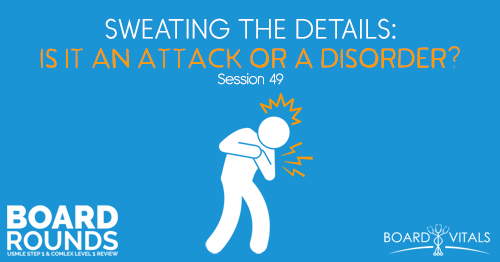Apple Podcasts | Google Podcasts

Session 33
This middle-aged male has hypertension and diabetes. Which cardiac abnormality is giving rise to his radiating, high-pitched, holosystolic murmur?
We’re joined by Dr. Mike Natter from BoardVitals. Go check out his amazing artwork on Instagram @mike.natter.
Listen to this podcast episode with the player above, or keep reading for the highlights and takeaway points.
[02:30] Question of the Week
A 58-year-old male is presenting for an evaluation of a heart murmur that was recently discovered at a work health fair. His past medical history is remarkable for hypertension and diabetes.
He has a nice chest pain, palpitations, syncope, or dyspnea. Cardiac auscultation reveals a high-pitched, blowing, holocystolic murmur at the apex. It radiates toward the axilla. The murmur does not increase in intensity with inspiration.
What is the most likely diagnosis?
(A) Mitral stenosis
(B) Ventricular septal defect
(C) Tricuspid regurgitation
(D) Aortic stenosis
(E) Mitral regurgitation
[Related episode: USMLE and COMLEX Prep: 60 y/o Male with a Murmur]
[03:43] Definition of Terms
Holosystolic means you hear the sound throughout systole. It’s not going away at any point, increasing or decreasing. It’s just going.
The apex of the heart is the opposite of the base. It can be sometimes confusing for medical students because it’s almost the opposite of what you look at when you’re looking at the heart. So the apex of the heart is located at the bottom. It’s the inferior part of the heart.
[06:17] The Correct Answer and the Thought Process Behind It
If it’s holosystolic, it’s the systole. The ventricles are contracting. So what we’re hearing is blood flowing back. It’s the regurgitation through either the tricuspid or the mitral valve. Typically, where you’re hearing the sound is the blood coming at you.
So I’m narrowing my choices here down to either (C) Tricuspid regurgitation or (E) Mitral regurgitation. Mike points out that it’s a good test-taking strategy to narrow down your choices. In this case, the correct answer is E.
You want to look at pitch, location, and timing. You can grade murmurs and where it radiates, etc. Based on what’s going on, we’re dealing with a regurgitating murmur.
The murmur of mitral regurgitation gives you this blowing holosystolic sound and radiating to the axilla. It’s a pathognomonic mitral regurgitant’s description. So anytime you hear that description, it’s telling of a mitral regurgitant murmur.
'Heart sounds are one of those things you just need to know inside and out.'Click To TweetIt’s essential to memorize the patterns because once that’s done, you’ll get those points easy.
[12:08] Understanding the Other Answer Choices
Mitral stenosis is characterized by more turbulent flows. Blood is trying to push through something that’s basically closed. With stenosis, imagine the blood is knocking at the door and you hear a very hard clunk, clunk, clunk. It’s very different from a blowing murmur or regurgitant-type murmur which sounds like a “woosh, woosh, woosh.”
Ventricular septal defect (VSD) is a defect between the two ventricles. What happens here is that blood is going to go from high pressure to low pressure. It sounds like a train going over a bridge “chug, chug, chug.” In this condition, you’re going to have the blood going from the left ventricle into the right ventricle. You will hear that extra sound in the heart as well.
You could hear this on the bicuspid area although it’s also going to be a holosystolic murmur. In systole, the ventricles are contracting. During that entire contraction, the blood that should be going to the aorta is also going to be flowing back into that right ventricle.
Interestingly, the tricuspid regurgitation and ventricular septal defect are potentiall going to sound the same in the same area. Obviously, it depends on how big the VSD is. There could be a pulmonary issue here, which you can tell in the clinical picture.
Aortic stenosis would be characterized by the smacking of blood up against the valve. You’re going to hear it in systole. But it’s not necessarily holosystolic. You’re only going to hear the murmur right when the blood is smacking up against the valve.
Depending on the level of stenosis, aortic stenosis can be one of the louder ones too. You can typically see some radiation to the carotids.
[17:50] Final Thoughts
Keep in mind that there are other aspects you have to get information from in order to really make a diagnosis. Unfortunately, we have to take these tests where we’re not really looking at the patient as a whole and getting a diagnosis as we should.
Students are given 4-6 weeks from schools and they’re studying 24 hours a day trying to maximize their score. But understand there’s a real patient behind there.
Mike suggests using a narrative or a story because the human memory works better in terms of ingraining that information and retrieving it appropriately.
Links:
BoardVitals (Use the promo code BOARDROUNDS to save 15% off.)
Dr. Mike Natter’s Instagram @mike.natter
SEARCH SITE
LISTEN FOR FREE











